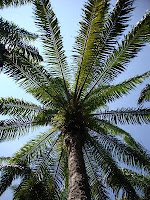I thought it would be a good idea to discuss the oil palm as part of this blog. There are 2 species of oil palm commonly cultivated. The more prevalent one is the African oil palm (Elaeis guineensis), though there is also an oil palm native to Central and South America (Elaeis oleifera). Mature trees can be as much as 20 meters or 65 feet tall, with pinnate leaves. Young trees produce about 30 leaves a year, while mature trees over 10 years of age produce about 20 leaves a year. Oil palms can be productive for up to 40 years, bearing fruit just 3 or 4 years after planting. Palm fruits take about 5 months from pollination to maturity. The tree can flower year round regardless of season. Since oil palms are very lucrative their cultivation has become an environmental as well as a socio-economic development issue in many parts of the world.
A high producing plantation can have up to 30 tons of fruit per hectare per year (1 hectare is about 2.47 acres). On average 1 hectare of oil palms can produce 7,250 liters or 1,915 gallons of palm oil per hectare per year. Palm fruits are usually purplish, the size of a plum and clustered in big bunches that weigh between 40 to 50 KG (88 to 110 lbs) each. Each fruit contains a single seed or kernel which is surrounded by an oily fruit pulp. Edible palm oil is extracted from the fruit pulp, while palm kernel oil is extracted from the kernel for use in both foods and soaps. 100 KG of oil palm fruits will yield 22 KG or 48.5 lbs of palm oil and 1.6 KG or 3.5 lbs of palm kernel oil. It takes about 600 hectares of oil palms to support 1 oil palm mill.
Palm oil is widely used in cooking in Asia and Africa and is gaining access to other world markets due to its lower pricing. It is popular because of the refined oils high oxidative stability and high levels of natural antioxidants. It contains more saturated fats than other competing oils like canola, sunflower or soybean, making it an excellent choice for deep frying. Other by-products include palm fronds for roofing and kernel meal used as livestock feed. Worldwide annual palm oil production is around 40 million metric tons (44 million US or imperial tons), with the vast majority of production occurring in Malaysia and Indonesia. Palm oils are the most widely produced tropical oil, and account for almost one-third of the world’s edible oil production.
However, oil palm production faces severe criticism in many quarters. The worst aspect is biodiversity loss, as countries like Malaysia have seen fit to cut down their rain forest to maximize oil palm acreage and production. Governments justify this on the basis that oil palms create significant socio-economic development and provide a lot of employment. One oil palm farmer in Costa Rica told me that their incomes went from $150 a month to $2,000 a month thanks to oil palms. Unfortunately many governments have failed to regulate when and where oil palm plantations can be planted, or have failed to enforce environmental laws, because of perceived socio-economic benefits. The arguments have become even more virulent in recent years, as oil palms have proven themselves to be an excellent source of bio-fuels, causing food versus fuel debates, as acreage is used to feed refineries instead of humans.




